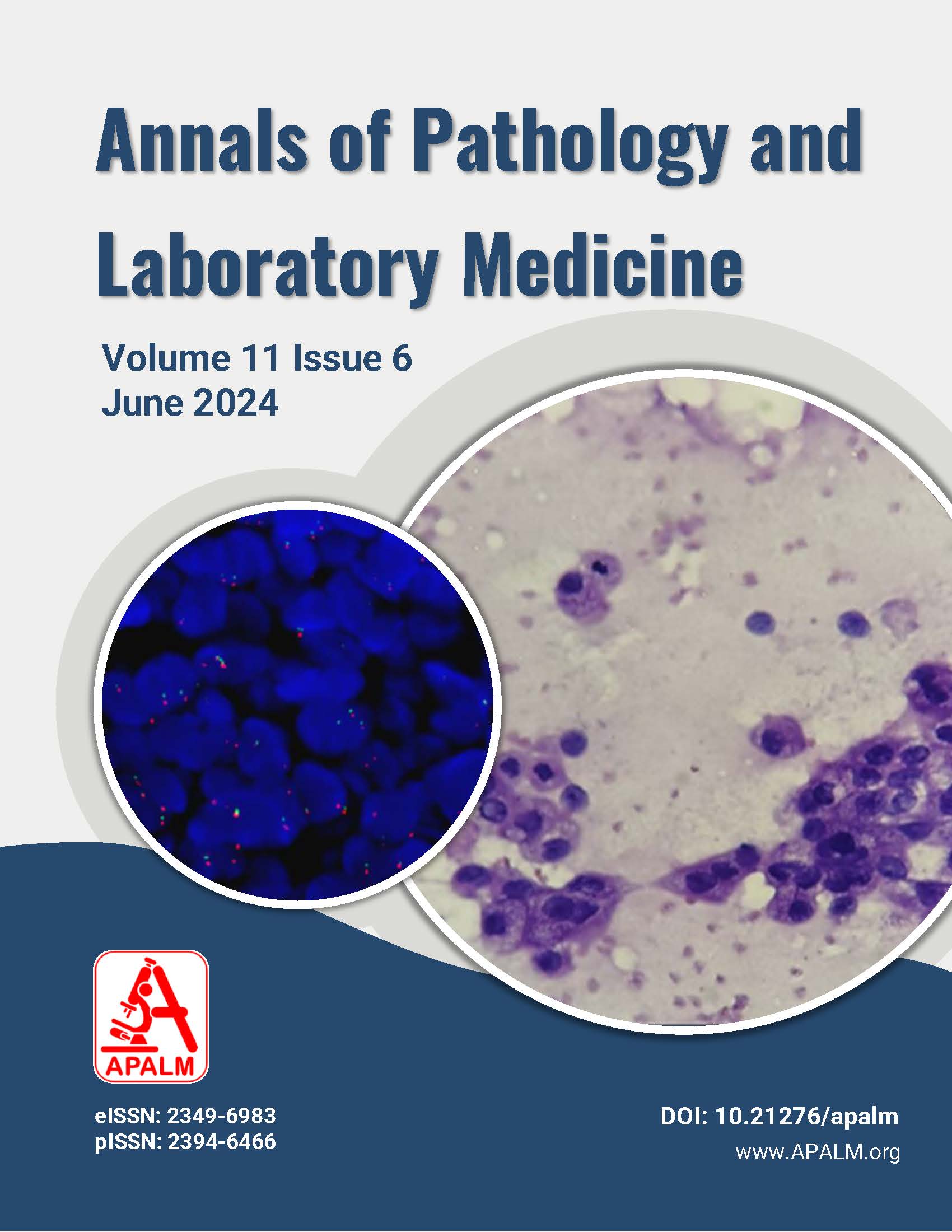Evaluation of Clinical and Cytological Profile of Breast Lesions at Tertiary Care Hospital, Bhavnagar
DOI:
https://doi.org/10.21276/apalm.3300Keywords:
FNAC, Sensitivity, Specificity, CytologyAbstract
Background
Breast lump is the common presentation of various breast lesions. Fine needle aspiration cytology (FNAC) is becoming popular as screening and diagnostic method for breast lesions due to its high sensitivity, specificity, low expenditure, conveniency and safety. The aim is to evaluate the demographic distribution and cytological diagnosis of breast lesions and correlate cytological diagnosis with histopathological diagnosis.
Methods
The present retrospective study was conducted on patients of breast lesion at Cytology Section, Pathology Department of Sir T General Hospital, Bhavnagar from 1st July 2021 to 30th June 2022. Data of FNAC findings of breast lump lesions from 1st January 2019 to 31st December 2020 was collected from reporting registers and statistical analysis was done.
Result
Data of 284 cases was available. Of which, 208 (73.23%) cases were diagnosed as benign of which Fibroadenoma was the most common, found in 116 (40.8%) cases with majority of the patients in 21- 40 year age group. Malignant lesions were found in 76 (26.76%) cases, of which Ductal carcinoma was the most common with 52 (18.30%) cases. Data of 64 cases were available for histopathological correlation. Sensitivity of FNAC was found to be 97.36% and specificity 100%.
Conclusion
As FNAC is a simple, easy, OPD based, cost effective procedure with high accuracy in diagnosis of breast lumps it should be used as preliminary investigation for early diagnosis of malignant lesions which can significantly reduce the morbidity and mortality associated with malignancy.
References
Sreedevi CH, Pushpalatha K. Correlative study of FNAC and histopathology for breast lesions. Trop J Path Micro. 2016;2:206-11.
Daramola AO, Odubanjo MO, Obiajulu FJ, et al. Correlation between fine-needle aspiration cytology and histology for palpable breast masses in a Nigerian Tertiary Health Institution. Int J Breast Cancer. 2015;2015:742573.
Bojia F, Demisse M, Dejane A, Bizuneh T. Comparison of fine needle aspiration cytology and excisional biopsy of breast lesions. East Afr Med J. 2001;78:226-8.
World Cancer Report [Internet]. 2020 [cited 2021 Apr 4]. Available from: https://www.iarc.who.int/cards_page/world-cancer-report
Mane PS, Kulkarni AM, Ramteke RV. Role of fine needle aspiration cytology in diagnosis of breast lumps. Int J Res Med Sci. 2017;5:3506-10.
Badge SA, Ovhal AG, Azad K, Meshram AT. Study of fine-needle aspiration cytology of breast lumps in rural area of Bastar district, Chhattisgarh. Med J Dr. DY Patil Univ. 2017 Jul 1;10(4):339.
Rosai J. Rosai and Ackerman’s Surgical Pathology. 10th ed. St Louis: Elsevier; 2012. p. 1660-1722.
Mitra S, Dey P. Grey zone lesions of breast: potential areas of error in cytology. J Cytol. 2015;32(3):145-52.
Shabb NS, Boulos FI, Abdulkarim FW. Indeterminate and erroneous fine-needle aspirates of breast with focus on the ‘true gray zone’: a review. Acta Cytol. 2013;57:316-31.
Panjvani SI, Parikh BJ, Parikh SB, Chaudhari BR, Patel KK, Gupta GS, et al. Utility of fine needle aspiration cytology in the evaluation of breast lesions. J Clin Diagn Res. 2013;7(12):2777-9.
Downloads
Published
Issue
Section
License
Copyright (c) 2024 Himali Kailashkumar Tandel, Mayuri Vasudevbhai Thaker, Rooju Shirishbhai Kevadiya

This work is licensed under a Creative Commons Attribution 4.0 International License.
Authors who publish with this journal agree to the following terms:
- Authors retain copyright and grant the journal right of first publication with the work simultaneously licensed under a Creative Commons Attribution License that allows others to share the work with an acknowledgement of the work's authorship and initial publication in this journal.
- Authors are able to enter into separate, additional contractual arrangements for the non-exclusive distribution of the journal's published version of the work (e.g., post it to an institutional repository or publish it in a book), with an acknowledgement of its initial publication in this journal.
- Authors are permitted and encouraged to post their work online (e.g., in institutional repositories or on their website) prior to and during the submission process, as it can lead to productive exchanges, as well as earlier and greater citation of published work (See The Effect of Open Access at http://opcit.eprints.org/oacitation-biblio.html).










